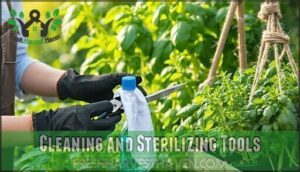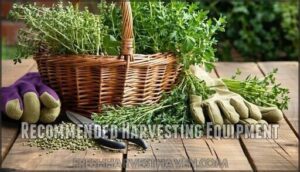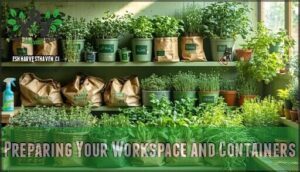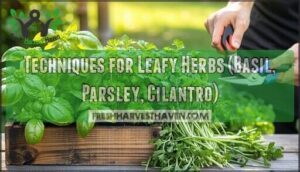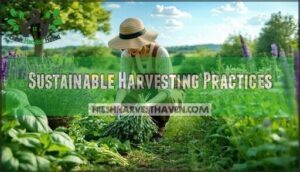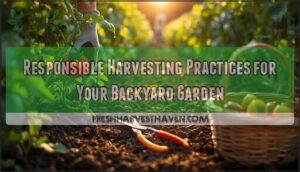This site is supported by our readers. We may earn a commission, at no cost to you, if you purchase through links.
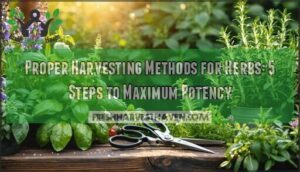 You’ll nail proper harvesting methods for herbs by timing it right and using clean tools. Harvest in early morning after dew dries but before the heat hits – that’s when essential oils peak. Look for vibrant green leaves and sturdy stems as your green light. Use sharp, sanitized scissors to make clean cuts without bruising.
You’ll nail proper harvesting methods for herbs by timing it right and using clean tools. Harvest in early morning after dew dries but before the heat hits – that’s when essential oils peak. Look for vibrant green leaves and sturdy stems as your green light. Use sharp, sanitized scissors to make clean cuts without bruising.
For annuals like basil, wait until you’ve got 5-10 main stems before your first harvest. Cut just above a leaf node to encourage new growth. Your herbs will thank you by producing more flavorful leaves throughout the season.
The real magic happens when you understand which parts to cut and exactly how much to take.
Table Of Contents
- Key Takeaways
- Choosing The Best Time to Harvest Herbs
- Essential Tools and Preparation for Harvesting
- Step-by-Step Harvesting Methods for Different Herbs
- Preserving and Storing Freshly Harvested Herbs
- Managing Harvests for Healthy, Productive Plants
- Frequently Asked Questions (FAQs)
- How to harvest herbs correctly?
- How do I cut my herbs so they keep growing?
- What is the proper method to harvest the plants?
- How often should I harvest my herbs?
- What is the best way to gather herbs?
- How do you sustainably harvest herbs?
- Should you cut or pull herbs?
- How do I harvest from my herb garden?
- How do you harvest herbs in the morning?
- How do you harvest a perennial herb?
- Conclusion
Key Takeaways
- Time your harvest perfectly – You’ll capture peak essential oils by harvesting early morning after the dew dries but before the heat hits, when herbs show vibrant green leaves and sturdy stems.
- Use proper cutting technique – You’ll encourage continuous growth by cutting just above leaf nodes with clean, sharp tools rather than pulling plants, which damages roots.
- Follow sustainable harvesting practices – You’ll keep plants productive by taking only one-third of the growth at once and waiting until annuals develop 5-10 main stems before the first harvest.
- Preserve herbs correctly for maximum flavor – You’ll maintain potency by air-drying bundles in ventilated areas or freezing in oil-filled ice cubes, storing them in airtight containers away from heat and light.
Choosing The Best Time to Harvest Herbs
You’ll get the most potent herbs when you harvest at just the right moment. Early morning after the dew dries but before the heat hits is your sweet spot for capturing those essential oils at their peak.
Identifying Signs of Herb Readiness
You’ll know your herbs are ready when leaf color shifts to vibrant green and stems feel sturdy. Check for node formation where new branches emerge.
Mature plants show thick stems and firm leaf texture. Annual herbs need 5-10 main stems before harvesting. Perennial herbs develop woody growth patterns.
These visual cues tell you when to harvest herbs for peak flavor.
Optimal Harvest Times of Day
Time your harvest right to release maximum flavor. Early Morning Harvest captures herbs at their peak potency when essential oils are concentrated. Here’s your timing playbook:
- Dawn to 10 AM: Harvest most herbs when dew has dried but before Peak Sun Hours
- Late afternoon: Perfect for second Daily Harvest Schedules if needed
- Avoid midday: Heat degrades essential oils and wilts leaves quickly
Smart timing transforms ordinary herbs into culinary gold. Understanding herb flavor cycles is vital for capturing the best flavor and aroma of your herbs.
Harvesting Annual Vs. Perennial Herbs
Herb classification matters for harvest timing. Annual herbs like basil complete their growth patterns in one season and need frequent harvesting to boost leaf production. You’ll harvest annual herbs throughout summer, cutting stems to prevent flowering.
Perennial herb harvesting works differently – these plants return yearly, so you can clip them regularly but stop before frost. Understanding how to harvest herbs based on their type ensures better plant regeneration and maximum yields.
For ideal results, consider using herb garden guides to inform your harvesting strategy.
Essential Tools and Preparation for Harvesting
You’ll need clean sharp scissors or pruning shears to make precise cuts that won’t damage your plants.
Clean your tools with rubbing alcohol before you start because dirty blades can spread diseases faster than gossip in a small town.
Cleaning and Sterilizing Tools
Cleaning your harvesting tools isn’t just good hygiene practices—it’s your first line of defense against plant diseases. **Tool sanitation prevents nasty pathogens from hitchhiking between plants.
** Use rubbing alcohol as your go-to cleaning solution for quick sterilization methods. Simply wipe blades before moving between different herb varieties.
**Equipment maintenance starts with this simple step that seasoned gardeners swear by.
** Having the right herb harvesting tools is essential for effective harvesting and plant care.
Recommended Harvesting Equipment
Sharp pruning shears are your best friend when harvesting herbs. You’ll need clean cutting tools like herb clippers for precision cuts. Don’t forget gardening gloves to protect your hands during the harvest process. A sturdy harvest basket or harvest tote keeps your bounty organized.
Your harvest crew of one deserves quality equipment that makes crop management feel less like work and more like meditation. Using the right harvesting garden tools can substantially improve the efficiency and safety of your harvesting process.
Preparing Your Workspace and Containers
Successful harvesting herbs starts with smart workspace preparation. Your herb garden deserves the same attention to detail as your kitchen. Set up your workspace sanitation routine before touching a single leaf.
- Clean surface areas – Wipe down tables with diluted bleach solution for workspace sanitation
- Organize containers – Arrange baskets, bags, and storage solutions within arm’s reach
- Prepare cleaning methods – Fill spray bottles with sanitizer for tool organization between cuts
- Label everything – Mark containers for different herbs to avoid mix-ups when preserving herbs
Container selection matters more than you’d think. Use breathable baskets for fresh herbs and airtight options for drying herbs later. Having the right herb gardening tools is essential for efficient harvesting and processing.
Step-by-Step Harvesting Methods for Different Herbs
You’ll learn specific techniques that work best for each type of herb in your garden. Different herbs need different approaches to keep them healthy and productive all season long.
Techniques for Leafy Herbs (Basil, Parsley, Cilantro)
Now that you’ve prepared your tools, it’s time to master leafy herb care through proper harvesting techniques. Start with the "cut and come again" method for herbs like parsley and cilantro.
| Herb | Cut Location | Growth Response |
|---|---|---|
| Basil | Above leaf nodes | Encourages branching |
| Parsley | At stem base | Promotes new shoots |
| Cilantro | Outer stems first | Extends harvest timing |
For harvest annual herbs, cut stems when plants show 5-10 main branches. This herb pruning approach maximizes leaf production while keeping plants healthy for fresh storage needs. To maintain ideal flavor, understanding proper harvesting techniques is essential for leafy herbs like basil.
Harvesting Flowering and Seed Herbs
For flowering herbs like lavender and dill, timing matters more than technique. When herb blooming reaches full flower but before seeds drop, you’ve hit the sweet spot.
Here’s your flower harvesting playbook:
- Cut entire flower heads early morning after dew evaporates
- Harvest annual herbs like coriander when flowers fade but seeds stay green
- Save perennial herbs’ best blooms for edible herb flowers in salads
Remember: seed production drains plant energy, so harvest those flowering stems promptly.
Sustainable Harvesting Practices
Beyond gathering seeds and flowers, you’ll want to protect Mother Earth while harvesting herbs. Apply eco friendly methods by following the "one in ten" rule—harvest only 10% from healthy stands. Use harvest scheduling and crop rotation to prevent soil depletion.
Practice biodiversity management by targeting weedy species first. These sustainable harvesting techniques keep your herb harvest abundant while preserving herbs for future generations. By adopting sustainable foraging practices, you can guarantee a healthy balance between harvesting and conservation.
Preserving and Storing Freshly Harvested Herbs
You’ve done the hard work of harvesting your herbs at just the right moment. Now comes the vital step that determines whether you’ll have flavorful seasonings all winter long or a jar of green dust that tastes like cardboard.
Drying Methods (Air, Oven, Microwave)
Traditional herb preservation starts with choosing your drying method. Air drying works best – just hang bundles upside down in a warm, dry spot for that old-school charm.
Each dehydration technique preserves different flavors and potencies.
- Air Drying: Hang herb bundles in ventilated areas for 1-2 weeks
- Oven Drying: Set to lowest temperature, dry for 2-4 hours
- Microwave Drying: Layer between paper towels, heat 1-2 minutes
Freezing and Oil Preservation Techniques
In the context of preserving herbs through freezing methods, you’ve got two solid options. Ice cube preservation works great for delicate herbs like basil and mint. Just chop them up, stuff them into ice cube trays, and cover with water or oil.
Oil infusion takes it up a notch. Blend your fresh herbs with olive oil before freezing. This herb blending technique locks in flavor better than plain frozen storage.
Proper Storage Containers and Conditions
Once you’ve mastered freezing and oil preservation, smart storage keeps your harvest fresh longer. Store dried herbs in airtight containers like glass jars on cool, dry herb shelves. Avoid moisture control mistakes by keeping containers away from heat and light.
Preserving herbs properly means refrigerating herbs stays fresh for weeks, not days. Understanding proper drying methods is essential for maintaining the potency of herbs.
Managing Harvests for Healthy, Productive Plants
You’ll turn your herb garden into a continuous harvest machine when you master the art of strategic cutting and timing.
Think of each harvest as a haircut that makes your plants stronger and more productive rather than weaker.
Encouraging Continued Growth and Branching
Smart pruning techniques make your herbs work harder for you. When harvesting, always cut just above a leaf node – this triggers the plant’s natural regrowth strategies. Each stem cutting creates two new branches, doubling your harvest potential.
For perennial herbs, clipping outer branches first encourages dense growth. Regular branch encouragement through strategic cutting back keeps plants bushy and productive.
Rotational Harvesting and Crop Management
Like rotational grazing for livestock, you’ll harvest perennial herbs in sections. Divide your herb patch into zones and rotate your harvest crew through each area weekly. This crop rotation approach gives plants recovery time while maintaining steady yields.
**Smart harvest scheduling prevents over-harvesting any single plant.
** Plan your farm layout to improve soil management and support continuous production throughout the growing season.
Common Post-Harvest Mistakes to Avoid
Rushing harvest timing ruins everything. You’ve grown beautiful herbs but spoil them with poor post-harvest handling.
Don’t harvest wet leaves—they’ll develop mold. Skip microwaving herbs unless you want bitter flavors. Store in plastic bags and watch crop contamination destroy your work.
Harvest perennial herbs correctly or face storage errors. Proper drying herbs and herb preservation methods prevent herb spoilage completely.
Frequently Asked Questions (FAQs)
How to harvest herbs correctly?
Your grandmother’s basil thrived because she pinched stems above leaf nodes daily.
You’ll harvest correctly by cutting annual herbs at their base when they’ve 5-10 stems, and snipping perennial herbs from outer branches just above nodes to encourage new growth.
How do I cut my herbs so they keep growing?
Cut just above a leaf node where two leaves meet the stem. This encourages branching and keeps your herbs bushy.
For basil, pinch flowers to maintain leafy growth.
Clean tools prevent disease spread.
What is the proper method to harvest the plants?
Harvest your herbs early morning when leaves are dry. Use clean, sharp scissors to cut stems just above leaf nodes.
This encourages new growth and keeps plants producing fresh leaves all season.
How often should I harvest my herbs?
You can harvest perennial herbs like rosemary and sage weekly or even daily.
Annual herbs need time to establish first – wait until they’ve developed five to ten main stems before regular harvesting begins.
What is the best way to gather herbs?
Like a medieval monk tending his monastery garden, you’ll want to gather herbs early morning when leaves are dry but dew’s gone. **Use clean, sharp scissors.
**
Cut stems just above leaf nodes to encourage new growth.
How do you sustainably harvest herbs?
You’ll want to take only what your plants can spare—never more than one-third of growth at once.
This keeps roots strong and ensures they’ll bounce back quickly for your next harvest.
Should you cut or pull herbs?
Cut herbs, don’t pull them. Cutting above a leaf node encourages new growth and keeps your plant producing. Pulling damages roots and can kill the plant entirely.
How do I harvest from my herb garden?
Ready to transform your garden into a treasure trove? **Start harvesting annual herbs when they’ve five main stems.
**
Cut perennials from outer branches above leaf nodes. Morning timing works best.
How do you harvest herbs in the morning?
Morning’s the sweet spot for herb harvesting. **You’ll want to head out after the dew dries but before the sun gets too intense.
** This keeps those essential oils locked in for maximum flavor and potency.
How do you harvest a perennial herb?
Perennial herbs can be harvested weekly since they regrow continuously. You’ll cut from outer branches just above a leaf node to encourage fresh growth and maintain the plant’s shape.
Conclusion
Like a wise gardener who knows when the fruit is perfectly ripe, mastering proper harvesting methods for herbs transforms your garden from ordinary to exceptional. You’ve learned the timing secrets, tool techniques, and preservation methods that’ll keep your herbs potent and productive.
Remember—it’s not just about cutting plants, it’s about building a relationship with them. Harvest with intention, store with care, and your herbs will reward you with flavors that’ll make store-bought seem like cardboard. Your kitchen awaits this homegrown magic.
- https://ucanr.edu/program/uc-anr-small-farms-network/handling-fresh-culinary-herbs
- https://pmc.ncbi.nlm.nih.gov/articles/PMC4243263/
- https://extension.psu.edu/harvesting-and-preserving-herbs-and-spices-for-use-in-cooking/
- https://www.reddit.com/r/gardening/comments/nmjddo/how_to_harvest_herb_plants/
- https://postharvest.ucdavis.edu/produce-facts-sheets/herbs-fresh-culinary

